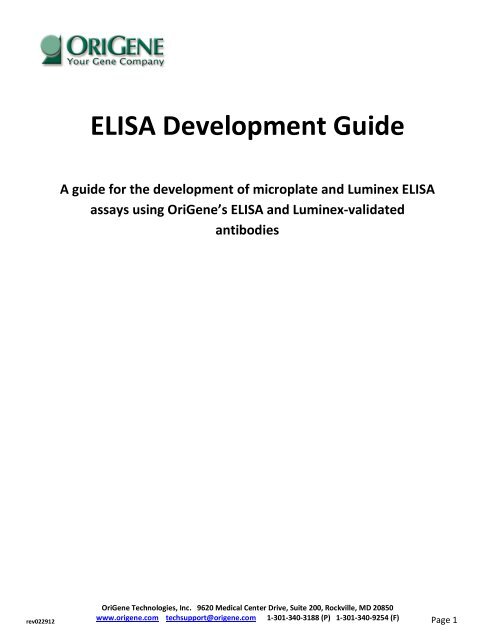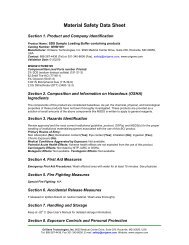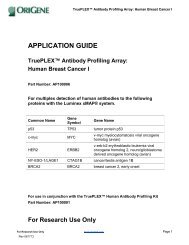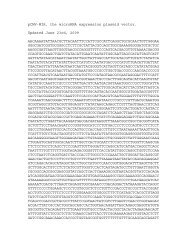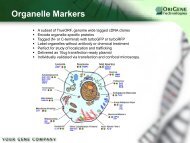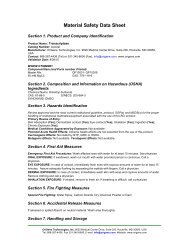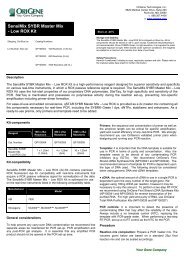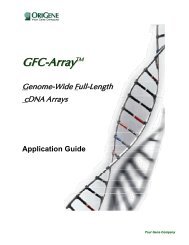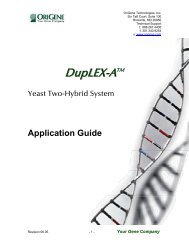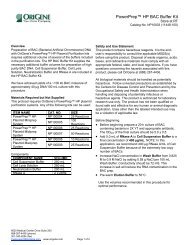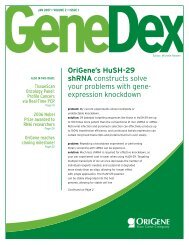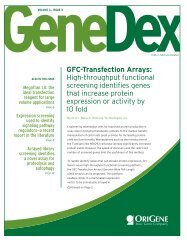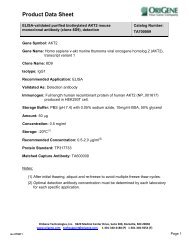ELISA Development Guide - OriGene
ELISA Development Guide - OriGene
ELISA Development Guide - OriGene
Create successful ePaper yourself
Turn your PDF publications into a flip-book with our unique Google optimized e-Paper software.
ev022912<br />
<strong>ELISA</strong> <strong>Development</strong> <strong>Guide</strong><br />
A guide for the development of microplate and Luminex <strong>ELISA</strong><br />
assays using <strong>OriGene</strong>’s <strong>ELISA</strong> and Luminex-validated<br />
antibodies<br />
<strong>OriGene</strong> Technologies, Inc. 9620 Medical Center Drive, Suite 200, Rockville, MD 20850<br />
www.origene.com techsupport@origene.com 1-301-340-3188 (P) 1-301-340-9254 (F) Page 1
ev022912<br />
<strong>OriGene</strong> Technologies, Inc. 9620 Medical Center Drive, Suite 200, Rockville, MD 20850<br />
www.origene.com techsupport@origene.com 1-301-340-3188 (P) 1-301-340-9254 (F) Page 2
ev022912<br />
Table of Contents<br />
<strong>ELISA</strong> Plate Coating .....................................................................................................................4<br />
Materials .................................................................................................................................4<br />
Antibody Plate Coating Procedure ...........................................................................................5<br />
Basic <strong>ELISA</strong> Protocol ...................................................................................................................6<br />
Materials .................................................................................................................................6<br />
Recommended Plate Layout ....................................................................................................7<br />
Preparation of Materials and Buffers ......................................................................................7<br />
Detailed <strong>ELISA</strong> Assay Protocol .................................................................................................8<br />
Data Analysis .........................................................................................................................10<br />
<strong>ELISA</strong> Protocol Summary .......................................................................................................11<br />
<strong>ELISA</strong> Assay Optimization .........................................................................................................12<br />
<strong>ELISA</strong> Assay Troubleshooting ....................................................................................................15<br />
Preparing Antibody-Coupled Luminex Beads ...........................................................................19<br />
Materials and Equipment Required .......................................................................................19<br />
Set-Up ...................................................................................................................................20<br />
Procedure Notes ...................................................................................................................20<br />
Coupling Procedure ...............................................................................................................21<br />
Luminex Assay Protocol............................................................................................................23<br />
Required or Recommended Reagents and Supplies ...............................................................23<br />
Equipment and software required: ........................................................................................24<br />
Setting the Luminex 100 or 200 for “High Gain” or “High PMT” Reading ...............................25<br />
Procedure Notes ...................................................................................................................25<br />
Recommended Plate Layout ..................................................................................................26<br />
Sample Collection and Preparation .......................................................................................26<br />
Dilution of Samples ...............................................................................................................27<br />
Reagent Preparation .............................................................................................................27<br />
Assay Protocol .......................................................................................................................28<br />
Data Analysis .........................................................................................................................31<br />
Luminex <strong>ELISA</strong> Protocol Summary ............................................................................................32<br />
Luminex Assay Optimization ....................................................................................................33<br />
Luminex <strong>ELISA</strong> Troubleshooting ...............................................................................................36<br />
Buffer and Reagent Preparation ...............................................................................................38<br />
Plate Plan Template .................................................................................................................41<br />
<strong>OriGene</strong> Technologies, Inc. 9620 Medical Center Drive, Suite 200, Rockville, MD 20850<br />
www.origene.com techsupport@origene.com 1-301-340-3188 (P) 1-301-340-9254 (F) Page 3
ev022912<br />
<strong>ELISA</strong> Plate Coating<br />
Materials<br />
Description Recommended Source<br />
<strong>ELISA</strong> Capture Antibody <strong>OriGene</strong> Technologies, Inc.<br />
Coating Buffer Prepared by user. See below and Buffer and Reagent Preparation.<br />
<strong>ELISA</strong> Plate Corning Costar #2592 (or equivalent)<br />
Plate Cover Corning Costar #3930 (or equivalent)<br />
Post-Coat/Blocking Buffer Prepared by user. See below and Buffer and Reagent Preparation.<br />
5.5" x 7.0" Ziplock Mylar Bag Sorbent Systems #55MFS07OZE or 6-mil Ziplock bag, VWR #<br />
82027-710<br />
Indicating Dessicant Sigma Cat. No. Z163562-100EA<br />
Absorbent Paper Towel WYPALL X60 towels from Kimberly Clark<br />
Coating Buffer<br />
Each capture antibody has been tested with three different coating buffers. The optimal<br />
coating buffer for each antibody is listed on the antibody data sheet. The three coating buffers<br />
tested are listed below. Formulations and instructions for preparing them can be found in the<br />
last section of this document, or by following the hyperlinks.<br />
100 mM Carbonate, pH 9.5<br />
100 mM Borate, pH 8.5<br />
100 mM Phosphate, pH 7.5<br />
<strong>ELISA</strong> Plates<br />
<strong>OriGene</strong> <strong>ELISA</strong>-validated capture antibodies are tested on Corning-Costar High-Binding stripwell<br />
plates, #2592. Other Corning-Costar high-binding plates should give similar results. Similar<br />
plates from Nunc and Greiner may also give acceptable results, but should be tested for each<br />
application. Each <strong>ELISA</strong> assay will need to be optimized for a specific type and vendor of<br />
microplate.<br />
Post-Coat/Blocking Buffer<br />
After antibody coating, plates are coated with a buffer that blocks the plate from further<br />
binding and preserves the coated antibody. For some applications, it may be beneficial to add<br />
additional blocking proteins to this buffer such as BSA, animal IgG, gelatin, casein, or non-fat<br />
dry milk. To prepare, see: Post-Coat/Blocking Buffer.<br />
<strong>OriGene</strong> Technologies, Inc. 9620 Medical Center Drive, Suite 200, Rockville, MD 20850<br />
www.origene.com techsupport@origene.com 1-301-340-3188 (P) 1-301-340-9254 (F) Page 4
ev022912<br />
Storage of antibody-coated microplates<br />
Although we have not done extensive stability studies, antibody-coated plates are usually quite<br />
stable when stored dessicated in sealed mylar bags at 2-8ºC. If Mylar bags are not available, a<br />
6-mil polyethylene Ziplock bag can also be used, but the desiccant will not last as long and will<br />
need to be replaced periodically.<br />
Antibody Plate Coating Procedure<br />
1. Immediately before use, dilute antibody to recommended dilution in Coating Buffer.<br />
Antibody coating concentrations of 2-8 g/ml are typical, but may vary significantly for<br />
some antibodies. Do not store diluted antibody.<br />
2. Add 70-100 l diluted antibody to each well.<br />
3. Cover and incubate plates overnight at room temperature. Shaking is not usually<br />
necessary.<br />
4. Aspirate liquid from wells so that no more than 5 l of diluted antibody remains.<br />
5. If more than 5 l of diluted antibody remains, then tap plates sharply on absorbent<br />
paper towel to remove remaining liquid.<br />
6. Add 250-300 l Post-Coat solution to each well.<br />
7. Cover and incubate plates for 3-4 hours (or overnight at 4ºC).<br />
8. Aspirate liquid from wells. If more than 5 l of Post Coat solution remains in the wells,<br />
then tap plates sharply on absorbent paper towel to remove remaining liquid.<br />
9. Plates are then ready for immediate or same-day use. For later use, plates should be<br />
dried for 3-24 hours at room temperature and then stored in a sealed Mylar bag<br />
containing a pack of indicating desiccant. Antibody-coated plates can generally be<br />
stored desiccated at 2-8ºC for up to 6 months.<br />
<strong>OriGene</strong> Technologies, Inc. 9620 Medical Center Drive, Suite 200, Rockville, MD 20850<br />
www.origene.com techsupport@origene.com 1-301-340-3188 (P) 1-301-340-9254 (F) Page 5
ev022912<br />
Basic <strong>ELISA</strong> Protocol<br />
Materials<br />
Description Recommended Source<br />
Antibody coated microplate See previous section.<br />
Assay Buffer<br />
For dilution of detection antibody,<br />
secondary antibodies, and<br />
streptavidin conjugates.<br />
Assay Diluent<br />
<strong>OriGene</strong> has four different Assay Buffers, each containing a<br />
different optimized mixture of buffer, salts, detergent and<br />
proteins. We recommend starting with Assay Buffer D.<br />
Different buffers may perform better than others<br />
depending upon the species origin of the capture and<br />
detection antibodies.<br />
Assay Buffer A - contains mouse and goat IgG Part No.: AR100012<br />
Assay Buffer B- contains BSA Part No.: AR100013<br />
Assay Buffer C- contains BSA and rabbit IgG Part No.: AR100014<br />
Assay Buffer D- contains BSA, mouse and goat IgG Part No.: AR100015<br />
Serum-based diluent for dilution of<br />
standards and samples.<br />
<strong>OriGene</strong>, Part No.: AR100016<br />
Contains heat-activated animal serum, detergent and a<br />
preservative.<br />
Biotinylated Detection Antibody <strong>OriGene</strong> biotinylated detection antibodies are supplied at<br />
0.5 mg/ml.<br />
<strong>ELISA</strong> Wash Buffer (10X) <strong>OriGene</strong> Part No.: AR100010 (100 ml), AR100011 (1L)<br />
Streptavidin-HRP Conjugate <strong>OriGene</strong> Part No.: AR100017<br />
TMB Substrate, soluble, 1-part <strong>OriGene</strong> Part No.: AR100018 (100 ml), AR100019 (1L)<br />
Stop Solution <strong>OriGene</strong> Part No.: AR100020 (100 ml), AR100021 (1L)<br />
Absorbent paper towels WYPALL X60 towels Kimberly Clark<br />
<strong>OriGene</strong> Technologies, Inc. 9620 Medical Center Drive, Suite 200, Rockville, MD 20850<br />
www.origene.com techsupport@origene.com 1-301-340-3188 (P) 1-301-340-9254 (F) Page 6
ev022912<br />
Recommended Plate Layout<br />
Before starting, it is recommended that a plate plan be designed. Such a plan will assist in assay<br />
workflow and data analysis. A suggested plate plan is shown below. A plate plan template is<br />
provided on page 41 (link here).<br />
1 2 3 5 6 7 8 9 10 11 12<br />
A Std 1 Std 1 Std 1<br />
B Std2 Std2 Std2<br />
C Std 3 Std 3 Std 3<br />
D Std 4 Std 4 Std 4<br />
E Std 5 Std 5 Std 5<br />
F Std 6 Std 6 Std 6<br />
G Std 7 Std 7 Std 7<br />
H Neg Neg Neg<br />
Std 1 is the highest concentration of the protein standard and Std 7 is the lowest concentration<br />
of the protein standard. The Negative wells contain the buffer or mixture that is used to dilute<br />
the standards. Running all standards, samples, and controls in duplicate or triplicate is<br />
recommended.<br />
Preparation of Materials and Buffers<br />
1. Prepare Wash Buffer by diluting 10X Wash Buffer to 1X with deionized water. Store<br />
diluted wash buffer at 2-8ºC for up to one month.<br />
2. For accurate quantitation, it is important to prepare protein standards in a matrix that<br />
mimics the composition of the samples. For example, if the samples are cell culture<br />
supernatants, then the protein standards should be prepared in the cell culture<br />
medium. For serum or plasma samples, dilute protein standards in <strong>OriGene</strong> Assay<br />
Diluent (AR100016) or similar serum- or plasma-based matrix.<br />
3. The performance of an <strong>ELISA</strong> assay can vary dramatically depending upon the<br />
composition of the samples, particularly with serum, plasma and other samples of<br />
clinical origin. Samples of clinical origin may contain substances that inhibit the assay<br />
causing falsely low readings. Dilution of samples with an appropriate matrix may reduce<br />
some or all of the inhibition or interference.<br />
<strong>OriGene</strong> Technologies, Inc. 9620 Medical Center Drive, Suite 200, Rockville, MD 20850<br />
www.origene.com techsupport@origene.com 1-301-340-3188 (P) 1-301-340-9254 (F) Page 7
ev022912<br />
Example:<br />
a. Protein stock concentration is 385 g/ml.<br />
b. Samples to be tested are serum samples<br />
c. Sample volume per well is 50 l.<br />
d. Total volume added per well is 100 l.<br />
To prepare a 1 ug/ml stock, add 1.3 l of protein stock to 498.7 l of Assay Buffer.<br />
To prepare Standard 1 at 100 ng/ml, add 100 l of the 1 g/ml stock to 900 l of<br />
Assay Diluent.<br />
To Make Add To Conc. (ng/ml)<br />
Standard 2 200 µl of Standard 1 400 µl of Assay Diluent 33.33<br />
Standard 3 200 µl of Standard 2 400 µl of Assay Diluent 11.11<br />
Standard 4 200 µl of Standard 3 400 µl of Assay Diluent 3.70<br />
Standard 5 200 µl of Standard 4 400 µl of Assay Diluent 1.23<br />
Standard 6 200 µl of Standard 5 400 µl of Assay Diluent 0.41<br />
Standard 7 200 µl of Standard 6 400 µl of Assay Diluent 0.14<br />
Detailed <strong>ELISA</strong> Assay Protocol<br />
1. Dilute samples into Assay Diluent or an appropriate matrix so that the signals will fall<br />
within the linear range of the assay.<br />
2. Add 100 μl prepared Standard to designated standard wells.<br />
3. Add 100 μl Assay Diluent to Negative wells.<br />
4. Add 100 μl diluted sample to designated sample wells.<br />
5. Cover and incubate the plate for 1-2 hours at room temperature on an orbital plate<br />
shaker (500-700 rpm).<br />
6. Ten to fifteen minutes before the end of this incubation, prepare working stock of<br />
Detection Antibody. Biotinylated detection antibody from <strong>OriGene</strong> is typically provided<br />
at 0.5 mg/ml. Check antibody data sheet for recommended working concentration.<br />
Typical working concentrations for colorimetric assays range from 0.5 to 2.0 g/ml.<br />
Lower working concentrations may be suitable for chemiluminescent assays.<br />
Example:<br />
a. Biotinylated detection antibody stock is 0.5 mg/ml.<br />
b. Working biotinylated detection antibody concentration is 1 g/ml.<br />
c. Prepare 100 l per well plus 10% extra.<br />
<strong>OriGene</strong> Technologies, Inc. 9620 Medical Center Drive, Suite 200, Rockville, MD 20850<br />
www.origene.com techsupport@origene.com 1-301-340-3188 (P) 1-301-340-9254 (F) Page 8
ev022912<br />
d. Assay uses 48 wells.<br />
e. Volume Assay Diluent required = 48*100*1.1 = 5280 l<br />
f. Volume detection antibody required = 5280 * 1/500 = 10.56 l<br />
Add 10.56 l biotinylated detection antibody to 5280 l of Assay Buffer.<br />
7. Aspirate solution from wells.<br />
8. Wash wells 3-5 times with 200-300 l of 1X Wash Buffer. If using an automated plate<br />
washer, fill wells completely before aspiration. After final wash, tap plate thoroughly on<br />
absorbent paper to remove all traces of wash buffer from the wells.<br />
9. Add 100 μl working stock of Detection Antibody to each well.<br />
10. Cover and incubate the plate for 1 hour at room temperature on an orbital plate shaker<br />
at 500-700 rpm.<br />
11. Ten to fifteen minutes before the end of this incubation, prepare the working solution<br />
of streptavidin-HRP (SA-HRP). A typical working concentration range for colorimetric<br />
assays is from 0.1 to 2.0 g/ml. Lower working concentrations may be suitable for<br />
chemiluminescent assays.<br />
Example:<br />
a. Streptavidin HRP stock is 1.0 mg/ml.<br />
b. Working streptavidin-HRP concentration is 0.5 g/ml.<br />
c. Prepare 100 l per well plus 10% extra.<br />
d. Assay uses 48 wells.<br />
e. Volume Assay Diluent required = 48*100*1.1 = 5280 l<br />
f. Volume SA-HRP stock required = (0.5/1000) * 5280 = 2.64 l<br />
Add 2.64 l of streptavidin-HRP to 5280 l of Assay Diluent.<br />
12. Wash wells 3-5 times with 200-300 l of 1X Wash Buffer. If using an automated plate<br />
washer, fill wells completely before aspiration. After final wash, tap plate thoroughly on<br />
absorbent paper to remove all traces of wash buffer from the wells.<br />
13. Add 100 l of diluted streptavidin-HRP to each well.<br />
14. Incubate plate at room temperature for 30 minutes on an orbital plate shaker at 500-<br />
700 rpm.<br />
15. Wash wells five times with 200-300 l of 1X Wash Buffer. If using an automated plate<br />
washer, fill wells completely before aspiration.<br />
16. After final wash, tap plate sharply on clean absorbent paper to remove all traces of<br />
wash buffer from the wells.<br />
17. Add 100 l soluble TMB substrate to each well.<br />
18. Cover the plate and incubate plate at room temperature for 15-30 minutes.<br />
<strong>OriGene</strong> Technologies, Inc. 9620 Medical Center Drive, Suite 200, Rockville, MD 20850<br />
www.origene.com techsupport@origene.com 1-301-340-3188 (P) 1-301-340-9254 (F) Page 9
ev022912<br />
19. Add 100 l of Stop Solution to each well. Incubate for 1-2 minutes.<br />
20. Read the absorbance at 450 nm.<br />
Data Analysis<br />
1. Use commercial data analysis software to analyze the data as analysis of <strong>ELISA</strong> data with<br />
Excel can be quite difficult. Many plate readers are sold with a software package that<br />
can be used to perform the analysis. Stand-alone analysis software is also available.<br />
ReaderFit from MiraiBio (Hitachi), Prism from GraphPad, and SigmaPlot from Systat are<br />
all suitable. A free (but limited) web-based analysis package is available at<br />
www.readerfit.com.<br />
2. Generate a standard curve by fitting the results of the protein standard data to a model<br />
equation.<br />
3. For microplate <strong>ELISA</strong> data, generally a 4-parameter logistic (4-PL) model gives a good fit.<br />
For some assays, a 5-parameter logistic (5-PL) model may give a better fit than the 4-PL<br />
model.<br />
4. To account for greater variance at the low end of the curve, it is recommended to<br />
consider 1/Y or 1/Y 2 weighting in conjunction with the 4-PL or 5-PL models.<br />
5. Use the standard curve to calculate the concentration of the analytes in the samples<br />
(unknowns). Be sure to adjust for any dilution of the samples relative to the standards.<br />
6. The following on-line articles provide additional in-depth discussion and analysis of the<br />
various factors and parameters to consider for <strong>ELISA</strong> data analysis.<br />
Tips for <strong>ELISA</strong> Data Analysis<br />
The 4 Parameter Logistic Regression Model<br />
The 5 Parameter Logistic Regression Model<br />
The Importance of Weighting with 4PL and 5PL Regression Models<br />
<strong>OriGene</strong> Technologies, Inc. 9620 Medical Center Drive, Suite 200, Rockville, MD 20850<br />
www.origene.com techsupport@origene.com 1-301-340-3188 (P) 1-301-340-9254 (F) Page 10
ev022912<br />
<strong>ELISA</strong> Protocol Summary<br />
1. Prepare standards and samples.<br />
2. Add 100 μl standards and samples to designated wells of capture plate.<br />
3. Cover and incubate the capture plate for 1-2 hours at room temperature on an orbital<br />
plate shaker (500-700 rpm). Prepare detection antibody.<br />
4. Wash wells 3-5 times with 200-300 l of 1X Wash Buffer.<br />
5. Add 100 μl Detection Antibody to each well.<br />
6. Cover and incubate the plate for 1 hour at room temperature on an orbital plate shaker<br />
at 500-700 rpm. Prepare streptavidin-HRP solution at end of incubation.<br />
7. Wash wells 3-5 times with 200-300 l of 1X Wash Buffer.<br />
8. Add 100 l of diluted streptavidin-HRP to each well.<br />
9. Incubate plate at room temperature for 30 minutes on an orbital plate shaker at 500-<br />
700 rpm.<br />
10. Wash wells five times with 200-300 l of 1X Wash Buffer.<br />
11. Add 100 l soluble TMB substrate to each well.<br />
12. Incubate plate at room temperature for 15-30 minutes.<br />
13. Add 100 l of Stop Solution to each well.<br />
14. Read absorbance at 450 nm.<br />
<strong>OriGene</strong> Technologies, Inc. 9620 Medical Center Drive, Suite 200, Rockville, MD 20850<br />
www.origene.com techsupport@origene.com 1-301-340-3188 (P) 1-301-340-9254 (F) Page 11
ev022912<br />
<strong>ELISA</strong> Assay Optimization<br />
Assays can be optimized for many different purposes such as maximum sensitivity, widest<br />
dynamic range, maximum specificity, improved linearity or recovery, or shortest time to results.<br />
Some common assay parameters that can be modified to achieve an optimal assay are listed in<br />
the table below.<br />
Parameter Modification Possible Effects<br />
Antibody Coating<br />
Concentration<br />
Antibody Coating<br />
Concentration<br />
Post-Coat/Blocking<br />
Buffer<br />
Increased Higher signal<br />
Higher background<br />
Lower limit of detection<br />
Faster capture<br />
Decreased Lower signal<br />
Lower background<br />
Wider dynamic range<br />
Longer capture time required<br />
Addition of a protein such as BSA,<br />
IgG, gelatin or casein at a<br />
concentration of 0.1 – 10 mg/ml<br />
Alternate Buffer and salt<br />
concentration<br />
Alternate detergent and/or<br />
detergent concentration.<br />
Lower background<br />
Lower limit of detection<br />
Improved recovery<br />
Improved stability<br />
Plate Type (Binding) High-binding vs Low-binding Difficult to predict but may<br />
significantly affect assay<br />
performance<br />
Plate Type (Color) Use of White or Black plates instead<br />
of clear with fluorescent or<br />
chemiluminescent detection<br />
Plate Vendor Use <strong>ELISA</strong> plates from different<br />
vendors<br />
Sample and Standard<br />
Diluent<br />
Standard<br />
Concentrations<br />
Samples and standards can be<br />
diluted into a different assay<br />
matrix.<br />
Standard can be diluted over<br />
different ranges<br />
Higher signal<br />
Higher sensitivity<br />
Wider dynamic range<br />
Difficult to predict. Plates<br />
from different vendors may<br />
give different results under<br />
identical assay conditions.<br />
Increased recovery<br />
Increased linearity<br />
Increased sensitivity<br />
Wider dynamic range<br />
Different dynamic range<br />
<strong>OriGene</strong> Technologies, Inc. 9620 Medical Center Drive, Suite 200, Rockville, MD 20850<br />
www.origene.com techsupport@origene.com 1-301-340-3188 (P) 1-301-340-9254 (F) Page 12
ev022912<br />
Parameter Modification Possible Effects<br />
Sample concentrations Samples can be used undiluted or<br />
can be diluted to different<br />
concentrations in an assay matrix<br />
Composition of Assay<br />
Matrix<br />
Addition of blocking agents such as<br />
proteins, polymers, or additional<br />
detergents<br />
Increase or decrease the salt (NaCl)<br />
concentration in the buffers<br />
Increase or decrease in the pH of<br />
the buffer<br />
Alternate buffers: Tris, borate, MES<br />
Increased recovery<br />
Optimal linearity<br />
Increased sensitivity<br />
Increased recovery<br />
Optimal linearity<br />
Increased sensitivity<br />
Reduced sample interference<br />
Capture time Increase or decrease Increased or decreased<br />
sensitivity.<br />
Wider dynamic range<br />
Number of Washes:<br />
Post-Capture<br />
Composition of Wash<br />
Buffer<br />
Biotinylated detection<br />
antibody concentration<br />
Increase or decrease Increased or decreased signal<br />
and/or background.<br />
Increased or decreased salt<br />
concentration<br />
Increased or decreased pH<br />
Increased or decreased detergent<br />
concentration<br />
Different buffer (Tris, etc.)<br />
Different detergent<br />
Increased or decreased assay<br />
time.<br />
Increased or decreased signal<br />
and/or background.<br />
Increased sensitivity<br />
Alternate dynamic range<br />
Reduced sample interference<br />
Improved recovery<br />
Increase or decrease Increased or decreased signal<br />
Increased or decreased<br />
sensitivity<br />
Wider or smaller dynamic<br />
range<br />
<strong>OriGene</strong> Technologies, Inc. 9620 Medical Center Drive, Suite 200, Rockville, MD 20850<br />
www.origene.com techsupport@origene.com 1-301-340-3188 (P) 1-301-340-9254 (F) Page 13
ev022912<br />
Parameter Modification Possible Effects<br />
Composition of the<br />
biotinylated detection<br />
antibody diluent<br />
Detection antibody<br />
incubation time<br />
Composition of the<br />
streptavidin-HRP<br />
conjugate diluent<br />
Streptavidin-HRP<br />
conjugate concentration<br />
Streptavidin-HRP<br />
incubation time<br />
Number of washes after<br />
Streptavidin-HRP<br />
incubation<br />
Addition of blocking agents such as<br />
proteins, polymers, or additional<br />
detergents.<br />
Increase or decrease in the salt<br />
(NaCl) concentration<br />
Increase or decrease in the buffer<br />
pH<br />
Alternate buffers: Tris, borate, MES<br />
Increased recovery<br />
Increased linearity<br />
Increased sensitivity<br />
Reduced sample interference<br />
Alternate buffer concentrations<br />
Increase or decrease. Increased or decreased signal<br />
Increased or decreased<br />
sensitivity<br />
Altered dynamic range<br />
Addition of blocking agents such as<br />
proteins, polymers, or additional<br />
detergents<br />
Increase or decrease in the salt<br />
(NaCl) concentration.<br />
Increase or decrease in the buffer<br />
pH<br />
Alternate buffers: Tris, borate, MES<br />
Increased or decreased signal<br />
Increased or decreased<br />
sensitivity<br />
Increased or decreased<br />
dynamic range<br />
Increased or decreased<br />
detection time<br />
Alternate buffer concentrations<br />
Increase or decrease Increased or decreased signal<br />
Increased or decreased<br />
sensitivity<br />
Alternate dynamic range<br />
Increase or decrease Increased or decreased signal<br />
Increased or decreased<br />
sensitivity<br />
Increase or decrease Increased or decreased signal<br />
and/or background.<br />
<strong>OriGene</strong> Technologies, Inc. 9620 Medical Center Drive, Suite 200, Rockville, MD 20850<br />
www.origene.com techsupport@origene.com 1-301-340-3188 (P) 1-301-340-9254 (F) Page 14
ev022912<br />
<strong>ELISA</strong> Assay Troubleshooting<br />
Problem Possible Causes Solutions<br />
High<br />
Background<br />
No Signal or<br />
Low Signal<br />
Insufficient washing Increase number of washes.<br />
Add 1-5 minute soak step between washes.<br />
Increase the volume of wash buffer per<br />
well.<br />
If using a plate washer, check to ensure<br />
that all ports are clean and that the target<br />
volume is delivered to all wells. Check that<br />
the residual volume after aspiration is less<br />
than 5 l per well.<br />
Detection antibody concentration is<br />
too high<br />
Streptavidin-HRP conjugate<br />
concentration is too high<br />
Check dilution. Titrate to find the optimal<br />
concentration.<br />
Use a medium-binding plate from a reliable<br />
source (Costar, Nunc, Greiner).<br />
Check dilution. Titrate to find the optimal<br />
concentration.<br />
Non-specific interactions Add additional protein to assay buffers and<br />
wash buffer.<br />
Contaminated buffers Remake buffers.<br />
Non-binding (eg, tissue culture)<br />
microplate used for antibody coating<br />
Diluted capture antibody stored in<br />
coating buffer for extended period<br />
before coating.<br />
Reagents omitted or added in<br />
incorrect order<br />
Incorrect standard was used or<br />
standard dilutions were made<br />
incorrectly<br />
Use a high-binding plate from a reliable<br />
source (Costar, Nunc, Greiner)<br />
Dilute antibody into coating buffer<br />
immediately before use. Do not store<br />
diluted capture antibody.<br />
Check calculations and protocol. Re-make<br />
solutions. Repeat assay.<br />
Verify that the correct standard was used.<br />
Check calculations for standard dilutions.<br />
Re-dilute standards.<br />
Inhibition of HRP by azide Make sure that the SA-HRP dilution buffer<br />
or final wash buffer does not contain azide.<br />
Concentration of Detection Antibody<br />
or Streptavidin-HRP is too low.<br />
Check dilution. Titrate to find the optimal<br />
concentration.<br />
<strong>OriGene</strong> Technologies, Inc. 9620 Medical Center Drive, Suite 200, Rockville, MD 20850<br />
www.origene.com techsupport@origene.com 1-301-340-3188 (P) 1-301-340-9254 (F) Page 15
ev022912<br />
Problem Possible Causes Solutions<br />
No Signal or<br />
Low Signalcontinued<br />
Too much<br />
signal – plate is<br />
uniformly blue<br />
or yellow.<br />
Capture antibody coated at too low a<br />
concentration<br />
Incorrect wavelength used in plate<br />
reader<br />
Titrate coating antibody concentration to<br />
determine optimal coating level.<br />
Read plate at 450 nm for yellow color (with<br />
stop solution).<br />
Read plate at 650 nm for blue color<br />
(without stop solution).<br />
Insufficient color development time Increase color development time until<br />
background is visible in the Negative<br />
Standard.<br />
Final washing step skipped or<br />
insufficient – unbound HRP remains<br />
in the wells<br />
Wash plates thoroughly according to the<br />
protocol. Increase the number of washes.<br />
Increase the volume of wash buffer used<br />
per well.<br />
Substrate contaminated Use a fresh bottle of substrate.<br />
Pour required amount of substrate into a<br />
new reagent reservoir. Do not return<br />
unused substrate to the bottle.<br />
Detection Antibody Concentration is<br />
too high<br />
Streptavidin-HRP Conjugate<br />
Concentration is too high.<br />
Plate sealers or reagent reservoirs<br />
contaminated by residual buffer or<br />
reagents<br />
Check dilution. Titrate to find the optimal<br />
concentration.<br />
Check dilution. Titrate to find the optimal<br />
concentration.<br />
Use a fresh plate sealer and reagent<br />
reservoir for each step.<br />
Insufficient washing Increase number of washes.<br />
Add 1-5 minute soak steps between<br />
washes.<br />
Increase the volume of wash buffer per<br />
well.<br />
Pipettors or plate washer are<br />
contaminated<br />
If using a plate washer, check to ensure<br />
that all ports are clean and that the target<br />
volume is delivered to all wells. Check that<br />
the residual volume after aspiration is less<br />
than 5 l per well.<br />
Clean pipettors and plate washer<br />
thoroughly. Test for residual HRP activity.<br />
<strong>OriGene</strong> Technologies, Inc. 9620 Medical Center Drive, Suite 200, Rockville, MD 20850<br />
www.origene.com techsupport@origene.com 1-301-340-3188 (P) 1-301-340-9254 (F) Page 16
ev022912<br />
Problem Possible Causes Solutions<br />
Poor<br />
reproducibility<br />
of duplicates<br />
Poor assay-toassay<br />
reproductibility<br />
Uneven concentration of antibody<br />
across the plate<br />
Check coating and blocking volumes.<br />
Check dispensing equipment.<br />
Incubate plate in a uniform environment.<br />
Use a high-binding microplate from a<br />
different vendor.<br />
Increase coating concentration.<br />
Extend blocking time to overnight.<br />
Insufficient washing Increase number of washes.<br />
Add a 1-5 minute soak steps with each<br />
wash.<br />
Increase the volume of wash buffer per<br />
well.<br />
If using a plate washer, check to ensure<br />
that all ports are clean and that the target<br />
volume is delivered to all wells. Check that<br />
the residual volume after aspiration is less<br />
than 5 l per well.<br />
Buffers contaminated Make fresh buffers.<br />
Use new reagent reservoirs for each<br />
reagent.<br />
If using a plate washer, clean,<br />
decontaminate, and use fresh wash buffer.<br />
Well-to-well carryover (from<br />
standards or positive samples)<br />
Insufficient or inconsistent washing<br />
Adjust shaker speed to minimize carryover.<br />
Completely seal wells with a plate sealer<br />
between steps or use a plate cover with<br />
individual rings that separate wells.<br />
Use a fresh plate sealer for each incubation.<br />
Increase number of washes.<br />
Add a 1-5 minute soak steps with each<br />
wash.<br />
Increase the volume of wash buffer per<br />
well.<br />
If using a plate washer, check to ensure<br />
that all ports are clean and that the target<br />
volume is delivered to all wells. Check that<br />
the residual volume after aspiration is less<br />
than 5 l per well.<br />
<strong>OriGene</strong> Technologies, Inc. 9620 Medical Center Drive, Suite 200, Rockville, MD 20850<br />
www.origene.com techsupport@origene.com 1-301-340-3188 (P) 1-301-340-9254 (F) Page 17
ev022912<br />
Problem Possible Causes Solutions<br />
Poor assay-toassay<br />
reproductibility-<br />
continued<br />
Samples are all<br />
above the<br />
linear range of<br />
the standard<br />
curve<br />
Standard curve<br />
is fine, but all<br />
samples are<br />
very low or<br />
negative<br />
Insufficient or inconsistent washing For manual washing, decanting technique<br />
may affect assay results. Develop a<br />
consistent procedure.<br />
Variations in incubation times or<br />
temperatures<br />
Incorrect dilution of protein<br />
standards<br />
Run assay in a consistent environment.<br />
All assay incubation times must be<br />
consistent from assay to assay.<br />
Check dilutions. Re-dilute and re-run assay.<br />
Variation in equipment used Use the same equipment from assay to<br />
assay including pipettors, shaker, plate<br />
washer, plate reader.<br />
Difference in the standard curve<br />
calculation<br />
Analyte concentration in samples is<br />
too high<br />
Assay sensitivity is not optimized for<br />
the natural range of the analyte<br />
No analyte in sample or analyte is<br />
present at a level below the limit of<br />
detection.<br />
Samples may contain an inhibitory<br />
factor<br />
Use the same equation to fit the standard<br />
curve.<br />
Dilute samples are re-run.<br />
Reduce detection antibody concentration.<br />
Reduce concentration of streptavidin-HRP.<br />
Reduce capture and detection incubation<br />
times.<br />
Re-dilute the protein standards to cover the<br />
appropriate range of the analyte.<br />
Increase the amount of sample used per<br />
well.<br />
Decrease the dilution factor of the samples.<br />
Spike a negative sample with protein<br />
standard and measure the recovery.<br />
Dilute samples 1:2 or further.<br />
<strong>OriGene</strong> Technologies, Inc. 9620 Medical Center Drive, Suite 200, Rockville, MD 20850<br />
www.origene.com techsupport@origene.com 1-301-340-3188 (P) 1-301-340-9254 (F) Page 18
ev022912<br />
Preparing Antibody-Coupled Luminex Beads<br />
Materials and Equipment Required<br />
Description Recommended Source<br />
Filter Plate (for Bead<br />
Coupling)<br />
<strong>OriGene</strong> Part No. AR100012 contains 5 filter plates and 15 plate<br />
sealers.<br />
Aluminum Plate Sealer <strong>OriGene</strong> Part No. AR100012 contains 5 filter plates and 15 plate<br />
sealers.<br />
EDC Pierce (Thermo Fisher) # 22980 (store dessicated at -20ºC)<br />
Sulfo-NHS Pierce (Thermo Fisher) # 24510 (store dessicated at -20ºC)<br />
Luminex MicroPlex ® or<br />
MagPlex® Microspheres<br />
Luminex Corp (www.luminexcorp.com), MiraiBio<br />
(www.miraibio.com), or Bio-Rad (www.bio-rad.com)<br />
<strong>ELISA</strong> Capture Antibody <strong>OriGene</strong> Technologies. Capture antibodies are supplied at 0.5<br />
mg/ml.<br />
NaH2PO4 (Sodium<br />
phosphate<br />
monobasic, anhydrous)<br />
Sigma # S3139<br />
Water, Ultra-pure Invitrogen # 10977 or equivalent<br />
MES Buffer Sigma # M2933<br />
5N NaOH ThermoFisher# SS256-500<br />
Tween-20 Sigma # P9416<br />
BSA Sigma # A7888<br />
10X PBS EMD Chemicals # 6506 or equivalent<br />
Sodium Azide Sigma # S8032<br />
<strong>ELISA</strong> Wash Buffer (10X) <strong>OriGene</strong> Part No.: AR100010 (100 ml), AR100011 (1L)<br />
Activation Buffer 100 mM Phosphate, pH 6.2 (see Buffer and Reagent Preparation)<br />
Coupling Buffer 50 mM MES, pH 5.0 (see Buffer and Reagent Preparation)<br />
Blocking Buffer (see Buffer and Reagent Preparation)<br />
Microplate vacuum manifold Pall #5017 Multi-well plate vacuum manifold (or equivalent)<br />
Vacuum pump or vacuum<br />
source<br />
Millipore WP6111560 Chemical Duty Pump, 115 V/60 Hz or<br />
equivalent<br />
Dessicant containers Plastic or glass containers containing dessicant.<br />
Absorbent paper towel WYPALL X60 towels from Kimberly Clark<br />
<strong>OriGene</strong> Technologies, Inc. 9620 Medical Center Drive, Suite 200, Rockville, MD 20850<br />
www.origene.com techsupport@origene.com 1-301-340-3188 (P) 1-301-340-9254 (F) Page 19
ev022912<br />
Set-Up<br />
Determine the wells to be used for coupling. Cover remaining wells with an aluminum Plate<br />
Sealer. It is most convenient to use wells in groups of 8 (columns) and to use an 8-channel<br />
pipettor for addition of reagents.<br />
The following protocol is designed for coupling of 0.5 - 8 g of antibody to 100-150 l (1.25-1.9<br />
x 10 6 ) of activated beads in a total volume of 150 l. An example plate layout is shown below.<br />
In this example, 4 different antibodies are being coupled at four different coupling ratios: 1.0,<br />
2.0, 3.0, and 4.0 g of antibody per well. Couple each antibody to a different bead region (0-<br />
100) so that all coupled beads can be assayed simultaneously.<br />
1 2 3 5 6 7 8 9 10 11 12<br />
A Ab1-1 Ab3-1<br />
B Ab1-2 Ab3-2<br />
C Ab1-3 Ab3-3<br />
D Ab1-4 Ab3-4<br />
E Ab2-1 Ab4-1<br />
F Ab2-2 Ab4-2<br />
G Ab2-3 Ab4-3<br />
H Ab2-4 Ab4-4<br />
Procedure Notes<br />
Wells covered by<br />
Aluminum Plate<br />
Sealer<br />
1. The vacuum pressure on the vacuum manifold should not exceed 5 mm Hg. Optimal<br />
filtration occurs between 1 and 4 mm Hg.<br />
2. The fluorescent beads are light sensitive and are especially sensitive to direct sunlight and<br />
incandescent light. Use aluminum foil to cover plates and tubes. Store plates in a dark<br />
location during incubations.<br />
3. After vacuum filtration, blot the bottom of the filter plate on clean absorbent material such<br />
as WYPALL X60 towels from Kimberly Clark.<br />
4. During loading or incubations do not place the filter plate on absorbent material as liquid<br />
will be drawn through the plate by wicking.<br />
<strong>OriGene</strong> Technologies, Inc. 9620 Medical Center Drive, Suite 200, Rockville, MD 20850<br />
www.origene.com techsupport@origene.com 1-301-340-3188 (P) 1-301-340-9254 (F) Page 20
ev022912<br />
Coupling Procedure<br />
Step 1<br />
Add 100 l 1X Wash Buffer to each well of the filter plate. Vacuum gently and<br />
blot.<br />
Step 2 Vortex bead stock for 10 seconds at high speed<br />
Step 3 Add 100-125 l of Bead Stock to each well of the filter plate<br />
Step 4 Vacuum gently and blot.<br />
Step 5 Wash beads 2 Times with 200 l Activation Buffer.<br />
Step 6 Vacuum gently and blot.<br />
Step 7 Add 80 l Activation Buffer to each well.<br />
Step 8 Shake plate at 1000 rpm for at least 5 minutes.<br />
Step 9 Prepare 50 mg/ml Sulfo-NHS in water.<br />
Step 10 Add 10 l of the 50 mg/ml Sulfo-NHS to each well.<br />
Step 11<br />
Prepare a 50 mg/ml solution of EDC in water. Work quickly as EDC is not stable in<br />
water.<br />
Step 12<br />
Add 10 l of the 50 mg/ml EDC to each well. Work quickly as EDC is not stable in<br />
water.<br />
Step 13 Mix wells by pipetting up and down 5 times.<br />
Step 14<br />
Shake plate for 20-30 minutes @ 600-1000 rpm in the dark or covered with a dark<br />
cover.<br />
Step 15 Mix wells by pipetting up and down 5 times.<br />
Step 16<br />
Shake plate for 20-30 minutes @ 600-1000 rpm in the dark or covered with a dark<br />
cover.<br />
Step 17 Wash Beads 3 Times with 200 l Coupling Buffer.<br />
Step 18 Vacuum gently and blot.<br />
Step 19 Add 146 l Coupling Buffer to each well.<br />
Add 2.0 l of antibody solution to the 1.0 g antibody wells.<br />
Add 4.0 l of antibody solution to the 2.0 g antibody wells.<br />
Step 20<br />
Add 6.0 l of antibody solution to the 3.0 g antibody wells.<br />
Add 8.0 l of antibody solution to the 4.0 g antibody wells.<br />
Step 21 Mix wells by pipetting up and down 5 times.<br />
Step 22 Mix for 1 hour with shaking at 600 RPM.<br />
Step 23 Mix wells by pipetting up and down 5 times.<br />
Step 24 Mix for 1-3 hours with shaking at 600 RPM.<br />
Step 25 Vacuum gently.<br />
Step 26 Wash 3 Times with 250 l Blocking Buffer.<br />
Step 27 Vacuum gently and blot.<br />
<strong>OriGene</strong> Technologies, Inc. 9620 Medical Center Drive, Suite 200, Rockville, MD 20850<br />
www.origene.com techsupport@origene.com 1-301-340-3188 (P) 1-301-340-9254 (F) Page 21
ev022912<br />
Step 29 Add 100 l Blocking Buffer to each well<br />
Step 30<br />
One well at a time, mix wells by pipetting up and down 5 times and then remove<br />
the solution containing suspended beads from the well.<br />
Step 31 Transfer the solution ( 100 l) to a new labeled tube.<br />
Step 32 Store beads @ 4ºC in the dark.<br />
(Optional). Count the beads to determine the bead concentration using a<br />
hemocytometer or a particle counting instrument such as a Cellometer.<br />
Step 33<br />
Alternatively, assume the beads are at a concentration of 10,000 beads per l and<br />
adjust the concentration after initial testing.<br />
<strong>OriGene</strong> Technologies, Inc. 9620 Medical Center Drive, Suite 200, Rockville, MD 20850<br />
www.origene.com techsupport@origene.com 1-301-340-3188 (P) 1-301-340-9254 (F) Page 22
ev022912<br />
Luminex Assay Protocol<br />
Required or Recommended Reagents and Supplies<br />
Description Recommended Source<br />
Filter Plate <strong>OriGene</strong> Part No. AR100012 contains 5 filter plates<br />
and 15 plate sealers.<br />
Aluminum Plate Sealer <strong>OriGene</strong> Part No. AR100012 contains 5 filter plates<br />
and 15 plate sealers.<br />
Luminex beads coupled with an <strong>OriGene</strong><br />
capture antibody<br />
Prepared as described in the coupling procedure.<br />
Biotinylated Detection Antibody <strong>OriGene</strong> Detection antibodies are supplied at 0.5<br />
mg/ml.<br />
Recombinant Protein for use as a protein<br />
standard<br />
Assay Buffer<br />
For dilution of detection antibody,<br />
secondary antibodies, and streptavidin<br />
conjugates.<br />
Assay Diluent<br />
<strong>OriGene</strong> proteins purified from HEK293 cells.<br />
<strong>OriGene</strong> over-expression HEK293 Cell Lysates.<br />
<strong>OriGene</strong> has four different Assay Buffers, each<br />
containing a different optimized mixture of buffer,<br />
salts, detergent and proteins. We recommend<br />
starting with Assay Buffer D. Different buffers may<br />
perform better than others depending upon the<br />
species origin of the capture and detection antibodies.<br />
Assay Buffer A- contains mouse and goat IgG Part No.: AR100012<br />
Assay Buffer B- contains BSA Part No.: AR100013<br />
Assay Buffer C- contains BSA and rabbit IgG Part No.: AR100014<br />
Assay Buffer D- contains BSA, mouse and goat IgG Part No.: AR100015<br />
Serum-based diluent for dilution of<br />
standards and samples.<br />
<strong>OriGene</strong>, Part No.: AR100016<br />
Contains heat-activated animal serum, detergent and<br />
a preservative.<br />
Streptavidin-Phycoerythrin Conjugate Moss PN: SAPE-001 1 mg/ml stock<br />
or<br />
<strong>OriGene</strong> PN: AM100109<br />
2 vials of 10X (30 g/ml) solution of streptavidin-PE in<br />
stabilizing buffer for use with Luminex immunoassays.<br />
Makes a 3 g/ml solution when diluted to 1X.<br />
Sufficient quantity for 192 assays.<br />
<strong>OriGene</strong> Technologies, Inc. 9620 Medical Center Drive, Suite 200, Rockville, MD 20850<br />
www.origene.com techsupport@origene.com 1-301-340-3188 (P) 1-301-340-9254 (F) Page 23
ev022912<br />
Equipment and software required:<br />
Description Recommended Supplier & Catalog No.<br />
Luminex 100, 200 or equivalent Luminex, Millipore, Hitachi, Bio-Rad<br />
Luminex Data Acquisition Software xPONENT 3.1<br />
Luminex IS 2.3<br />
Luminex LDS 1.7<br />
BioPlex Manager<br />
Vortex Mixer VWR Analog Vortex Mixer<br />
58816-121 (120V)<br />
58816-123 (230V)<br />
Mini centrifuge VWR Minifuge<br />
93000-196 (120V)<br />
93000-198 (230V)<br />
Orbital Shaker Eppendorf Mix Mate<br />
022674200 (120V/60Hz)<br />
022674226 (230V/50Hz)<br />
Water Bath Sonicator Bransonic Model B3/B5<br />
000-951-005 (Model B3, 115V)<br />
000-951-103 (Model B5, 230V)<br />
Microplate vacuum manifold with<br />
pressure gauge<br />
Pall Multi-well plate vacuum manifold (PN<br />
5017).<br />
Data Analysis Software MasterPlex QT from Hitachi Software or<br />
equivalent. A free trial download is<br />
available.<br />
<strong>OriGene</strong> Technologies, Inc. 9620 Medical Center Drive, Suite 200, Rockville, MD 20850<br />
www.origene.com techsupport@origene.com 1-301-340-3188 (P) 1-301-340-9254 (F) Page 24
ev022912<br />
Note : To achieve optimal results, the use of the “High Gain” or “High PMT” setting on the<br />
Luminex 100 or 200 is recommended. Some instruments may use this setting as the default.<br />
Check with your instrument supplier for more information.<br />
Setting the Luminex 100 or 200 for “High Gain” or “High PMT” Reading<br />
1. Create a new lot number for Cal 2 and enter it into the Luminex software as a new Cal 2 lot<br />
number (use the actual lot number with an HG at the end to designate High Gain).<br />
2. Record the Cal 2 target value, which is usually around 3800.<br />
3. Multiply the Cal 2 target value by 4.55 to get a new Target value of approximately 17,290.<br />
4. Enter the new Target Value as the value for your "New" Cal 2 lot.<br />
5. Run the Cal 2 Calibration.<br />
Procedure Notes<br />
1. The vacuum pressure on the vacuum manifold should not exceed 5 mm Hg. Optimal<br />
filtration occurs between 1 and 4 mm Hg.<br />
2. The fluorescent beads are light sensitive and are especially sensitive to direct sunlight and<br />
incandescent light. Use aluminum foil to cover plates and tubes. Store plates in a dark<br />
location during incubations.<br />
3. After vacuum filtration, blot plates on clean absorbent material such as WYPALL X60 towels<br />
from Kimberly Clark.<br />
4. During loading or incubations do not place the filter plate on absorbent material as liquid<br />
will be drawn through the plate by wicking.<br />
<strong>OriGene</strong> Technologies, Inc. 9620 Medical Center Drive, Suite 200, Rockville, MD 20850<br />
www.origene.com techsupport@origene.com 1-301-340-3188 (P) 1-301-340-9254 (F) Page 25
ev022912<br />
Recommended Plate Layout<br />
Before starting, it is recommended that a plate plan be designed. Such a plan will assist in assay<br />
workflow and data analysis. A suggested plate plan is shown below. A plate plan template is<br />
provided in the appendix.<br />
1 2 3 5 6 7 8 9 10 11 12<br />
A Std 1 Std 1 Std 1<br />
B Std2 Std2 Std2<br />
C Std 3 Std 3 Std 3<br />
D Std 4 Std 4 Std 4<br />
E Std 5 Std 5 Std 5<br />
F Std 6 Std 6 Std 6<br />
G Std 7 Std 7 Std 7<br />
H Neg Neg Neg<br />
Std 1 is the highest concentration and Std 7 is the lowest concentration.<br />
Running all standards, samples, and controls in duplicate or triplicate is recommended.<br />
Sample Collection and Preparation<br />
1. Serum, plasma and tissue culture supernatants are common sample types and will<br />
generally be suitable for testing with this protocol. Protocols for additional sample<br />
types will need to be tested and validated.<br />
2. Avoid the use of lipemic or hemolyzed samples.<br />
Sample<br />
Wells<br />
3. Collect serum and plasma samples according to standard protocols. Immediately mix<br />
and separate, and then aliquot the samples into polypropylene tubes. If not tested<br />
immediately, store samples at -80ºC.<br />
4. Analyze fresh samples as quickly as possible after collection. Allow frozen samples to<br />
thaw on ice, then mix well before testing. Avoid multiple freeze-thaw cycles of frozen<br />
samples.<br />
5. Turbid samples should be clarified by centrifugation before use.<br />
6. If the measured analyte concentrations exceed the value of the upper range of the<br />
standard curve, dilute samples appropriately and reanalyze. Dilute serum and plasma<br />
samples in Assay Diluent or Assay Buffer. Dilute tissue culture supernatants in tissue<br />
culture medium or Assay Buffer.<br />
<strong>OriGene</strong> Technologies, Inc. 9620 Medical Center Drive, Suite 200, Rockville, MD 20850<br />
www.origene.com techsupport@origene.com 1-301-340-3188 (P) 1-301-340-9254 (F) Page 26
ev022912<br />
7. For accurate quantitation, it is important that the composition of the standards be<br />
exactly the same as the composition of the samples. Dilute the standards in a buffer<br />
that reflects the final composition of the samples after dilution.<br />
Dilution of Samples<br />
It is important to dilute the samples so that the analyte levels are within the linear range of the<br />
assay and to minimize the effect of the sample matrix on the sample assay.<br />
Reagent Preparation<br />
1. Prepare Wash Buffer by diluting 10X Wash Buffer to 1X with deionized water. Store diluted<br />
wash buffer at 2-8ºC for up to one month.<br />
2. For accurate quantitation, it is important to prepare protein standards in a matrix that<br />
mimics the composition of the samples. For example, if the samples are cell culture<br />
supernatants, then the protein standards should be prepared in the cell culture medium.<br />
For serum or plasma samples, dilute protein standards in <strong>OriGene</strong> Assay Diluent (AR100016)<br />
or similar serum- or plasma-based matrix.<br />
3. The performance of a Luminex <strong>ELISA</strong> assay can vary dramatically depending upon the<br />
composition of the samples, particularly with serum, plasma and other samples of clinical<br />
origin. Samples of clinical origin may contain substances that inhibit the assay causing<br />
falsely low readings. Dilution of samples with an appropriate matrix may reduce some or all<br />
of inhibition or interference.<br />
Example – Serum Samples:<br />
a. Protein stock concentration is 385 g/ml.<br />
b. Samples to be tested are serum samples.<br />
c. Sample volume per well is 50 l.<br />
d. Total volume added per well is 100 l.<br />
Assay matrix is a mixture of 50% cell Assay Diluent and 50% Assay Buffer B.<br />
To prepare a 1 ug/ml stock, add 1.3 l of protein stock to 498.7 l of Assay Buffer B.<br />
To prepare Standard 1 at 100 ng/ml, add 100 l of the 1 g/ml stock to 900 l of<br />
Assay Matrix.<br />
To Make Add To Conc. (ng/ml)<br />
Standard 2 200 µl of Standard 1 400 µl of Assay Matrix 33.33<br />
Standard 3 200 µl of Standard 1 400 µl of Assay Matrix 11.11<br />
Standard 4 200 µl of Standard 1 400 µl of Assay Matrix 3.70<br />
<strong>OriGene</strong> Technologies, Inc. 9620 Medical Center Drive, Suite 200, Rockville, MD 20850<br />
www.origene.com techsupport@origene.com 1-301-340-3188 (P) 1-301-340-9254 (F) Page 27
ev022912<br />
Standard 5 200 µl of Standard 1 400 µl of Assay Matrix 1.23<br />
Standard 6 200 µl of Standard 1 400 µl of Assay Matrix 0.41<br />
Standard 7 200 µl of Standard 1 400 µl of Assay Matrix 0.14<br />
Filter Plate<br />
Before starting the assay, cover the wells that will not be used in the assay with an aluminum<br />
plate sealer. Press sealer down so that all wells are tightly sealed. Trim edges with a razor<br />
blade.<br />
Bead Mix<br />
Prepare Bead Mix in Assay Buffer or 1X Wash Buffer containing 1 mg/ml BSA. Dilute beads to a<br />
final concentration of 25 beads per µl.<br />
Example:<br />
a. Bead stocks are at a concentration of 10,000 per µl.<br />
b. Prepare 100 l per well plus 10% extra.<br />
c. Assay uses 48 wells.<br />
d. Volume Assay Buffer B required = 48*100*1.1 = 5280 l<br />
e. Volume bead stock required = 5280 * 25/10,000 = 13.2 l<br />
Assay Protocol<br />
Add 13.2 l of each bead stock to 5280 l of Assay Buffer B.<br />
f. When all beads have been added, vortex thoroughly for 10 seconds and then<br />
sonicate for 2 minutes.<br />
Analyte Capture<br />
1. Briefly vortex the 1X Bead Mix. Add 100 μl of 1X Bead Mix to each assay well (this is<br />
approximately 2500 beads of each type per well).<br />
2. Remove liquid from the plate by gentle vacuum. Blot plate thoroughly on absorbent<br />
paper.<br />
3. Add 100 μl diluted standards into designated standard wells (including negative).<br />
4. Add 50 μl serum samples into designated sample wells.<br />
5. Add 50 ul Assay Buffer B into the designated sample wells.<br />
6. Cover and incubate the plate for 1-2 hours at room temperature on an orbital plate<br />
shaker (500-700 rpm).<br />
<strong>OriGene</strong> Technologies, Inc. 9620 Medical Center Drive, Suite 200, Rockville, MD 20850<br />
www.origene.com techsupport@origene.com 1-301-340-3188 (P) 1-301-340-9254 (F) Page 28
ev022912<br />
7. Ten to fifteen minutes before the end of this incubation, prepare 1X Detection Antibody<br />
at 0.5-4 g/ml.<br />
Example:<br />
a. Biotinylated detection antibody stock is 0.5 mg/ml.<br />
b. Working biotinylated detection antibody concentration is 2 g/ml.<br />
c. Prepare 100 l per well plus 10% extra.<br />
d. Assay uses 48 wells.<br />
e. Volume Assay Buffer B required = 48*100*1.1 = 5280 l<br />
f. Volume detection antibody required = 5280 * 2/500 = 21.12 l<br />
Analyte Detection<br />
Add 21.12 l biotinylated detection antibody to 5280 l of Assay Buffer D.<br />
8. Remove the liquid from the wells by gentle vacuum.<br />
9. Wash beads three time by adding 100 μL 1X Wash Buffer to the wells and removing<br />
liquid with gentle vacuum.<br />
10. After washing, blot plate thoroughly on absorbent material.<br />
11. Add 100 μl Detection Antibody into each well.<br />
12. Cover and incubate the plate for 1-2 hours at room temperature on an orbital plate<br />
shaker at 500-700 rpm.<br />
13. During this incubation, prepare the Luminex instrument for reading (see below).<br />
14. During the last 10 minutes of this incubation, prepare the Detection Reagent<br />
(Streptavidin-Phycoerythrin).<br />
Preparation of Detection Reagent (Streptavidin-Phycoerythrin Conjugate<br />
Method 1 – Dilution of Moss 1 mg/ml SAPE concentrate:<br />
a. Streptavidin-Phycoerythrin (SAPE) stock is 1.0 mg/ml.<br />
b. Working SAPE concentration is 2 g/ml.<br />
c. Prepare 100 l per well plus 10% extra.<br />
d. Assay uses 48 wells.<br />
e. Volume Assay Diluent required = 48*100*1.1 = 5280 l<br />
f. Volume SAPE stock required = (2/1000) * 5280 = 10.56 l<br />
Add 10.56 l of SAPE to 5280 l of Assay Buffer D.<br />
Method 2 – Dilution of TruePlex 10X Detection Reagent Concentrate:<br />
a. Prepare 100 l per well plus 10% extra.<br />
<strong>OriGene</strong> Technologies, Inc. 9620 Medical Center Drive, Suite 200, Rockville, MD 20850<br />
www.origene.com techsupport@origene.com 1-301-340-3188 (P) 1-301-340-9254 (F) Page 29
ev022912<br />
b. Assay uses 48 wells.<br />
c. Total Volume Required = 48 * 100 * 1.1 = 5280 l<br />
d. Volume Assay Diluent required = 0.9 * 5280 = 4754 l<br />
e. Volume 10X Detection Reagent required = 0.1 * 5280 = 528 l<br />
Add 528 l of 10X Detection Reagent to 4754 l of Assay Buffer D.<br />
Prepare the Luminex instrument for reading<br />
15. Set up the instrument as described in the user’s manual. Instruments from different<br />
vendors may have different set-up procedures.<br />
16. Warm up the instrument. This may take up to 30 minutes.<br />
17. General Parameter settings:<br />
The XY platform heater should be off.<br />
The minimum events setting should be 30.<br />
The sample size should be set to 50 μL.<br />
The flow rate should be set to Fast.<br />
18. Enter the analyte names and bead numbers.<br />
19. Check the probe height and adjust it, if necessary to accommodate the filter plate.<br />
20. Perform one prime cycle with sheath fluid, one alcohol flush, and two sheath fluid<br />
washes.<br />
21. Calibrate to “High Gain” setting if necessary (see page 25).<br />
Detection with Streptavidin-Phycoerythrin<br />
22. Remove the liquid in the wells by gentle vacuum.<br />
23. Wash beads three times by adding 100 μl 1X Wash Buffer to all wells and removing<br />
liquid with gentle vacuum.<br />
24. Blot plate thoroughly on absorbent material.<br />
25. Add 100 μl Detection Reagent (Streptavidin-PE conjugate) into each well.<br />
26. Cover and incubate the plate for 30 minutes at room temperature on an orbital plate<br />
shaker at 500-700 rpm.<br />
27. Wash beads three times by adding 100 μl 1X Wash Buffer to all wells and then removing<br />
liquid with gentle vacuum.<br />
28. Blot plate thoroughly on absorbent material.<br />
29. Add 100 μL 1X Wash Buffer to each well.<br />
<strong>OriGene</strong> Technologies, Inc. 9620 Medical Center Drive, Suite 200, Rockville, MD 20850<br />
www.origene.com techsupport@origene.com 1-301-340-3188 (P) 1-301-340-9254 (F) Page 30
ev022912<br />
30. Optional: shake plate for 2 minutes on an orbital plate shaker at 500-700 rpm (this<br />
optional step may increase the bead count during Luminex reading.<br />
31. Read the plate in the Luminex instrument.<br />
Data Analysis<br />
1. Use commercial data analysis software to analyze the data as analysis of <strong>ELISA</strong> data with<br />
Excel can be quite difficult. Some Luminex instruments may come with analysis<br />
software. MasterPlex ReaderFit or MasterPlex QT from Hitachi software<br />
(www.miraibio.com) are suitable third-party software packages for quantitative analysis<br />
of Luminex <strong>ELISA</strong> data. Time-limited trial versions can be downloaded from<br />
www.miraibio.com . Follow the instructions for installing the software and licenses.<br />
2. Tutorials in PDF format, PowerPoint presentations, FAQs and other training materials<br />
are also available on the MiraiBio website.<br />
3. A free web-based data analysis tool is available at www.readerfit.com. The free version<br />
is limited to analyzing a total of 32 data points (standards and samples), but a paid<br />
version allows broader use.<br />
7. Enter the data for your standards and samples and generate a standard curve by fitting<br />
the results of the protein standard data to a model equation.<br />
8. For Luminex assays, a 5-parameter logistic regression with 1/Y 2 weighting usually gives<br />
the best fit.<br />
9. Use the standard curve to calculate the concentration of the analytes in the samples<br />
(unknowns). Be sure to adjust for any dilution of the samples relative to the standards.<br />
10. The following on-line articles provide additional in-depth discussion and analysis of the<br />
various factors and parameters to consider for <strong>ELISA</strong> data analysis.<br />
Tips for <strong>ELISA</strong> Data Analysis<br />
The 4 Parameter Logistic Regression Model<br />
The 5 Parameter Logistic Regression Model<br />
The Importance of Weighting with 4PL and 5PL Regression Models<br />
<strong>OriGene</strong> Technologies, Inc. 9620 Medical Center Drive, Suite 200, Rockville, MD 20850<br />
www.origene.com techsupport@origene.com 1-301-340-3188 (P) 1-301-340-9254 (F) Page 31
ev022912<br />
Luminex <strong>ELISA</strong> Protocol Summary<br />
1. Prepare standards and samples.<br />
2. Dilute beads to 25 beads/l in Assay Buffer.<br />
3. Add 100 μl beads to each well of a filter plate.<br />
4. Vacuum gently to remove liquid and blot thoroughly.<br />
5. Add 100 μl standards and samples to the appropriate wells.<br />
6. Cover and incubate the plate for 1-2 hours at room temperature on an orbital plate<br />
shaker at 500-700 rpm. Prepare Detection Antibody.<br />
7. Warm up the Luminex instrument.<br />
8. Wash wells three times with 100 l of 1X Wash Buffer Vacuum gently and blot.<br />
9. Add 100 μl Detection Antibody to each well.<br />
10. Cover and incubate the plate for 1-2 hours at room temperature on an orbital plate<br />
shaker at 500-700 rpm. Prepare SAPE solution at 2-4 g/ml.<br />
11. Wash wells three times with 100 l of 1X Wash Buffer. Vacuum gently and blot.<br />
12. Add 100 l of diluted SAPE to each well.<br />
13. Incubate plate at room temperature for 30 minutes on an orbital plate shaker at 500-<br />
700 rpm.<br />
14. Prepare the Luminex instrument for reading.<br />
15. Wash wells three times with 100 l of 1X Wash Buffer. Vacuum gently and blot.<br />
16. Add 100 l 1X Wash Buffer to each well.<br />
17. Read plate in Luminex instrument.<br />
<strong>OriGene</strong> Technologies, Inc. 9620 Medical Center Drive, Suite 200, Rockville, MD 20850<br />
www.origene.com techsupport@origene.com 1-301-340-3188 (P) 1-301-340-9254 (F) Page 32
ev022912<br />
Luminex Assay Optimization<br />
Assays can be optimized for many different purposes such as maximum sensitivity, widest<br />
dynamic range, maximum specificity, improved linearity or recovery, or shortest time to results,<br />
to give a few examples. Some common assay parameters that can be modified to achieve an<br />
optimal assay are listed in the table below.<br />
Parameter Modification Possible Effects<br />
Antibody Coupling<br />
Concentration<br />
Increase or Decrease the amount of<br />
antibody used in the coupling<br />
reaction.<br />
Standard<br />
Standard can be diluted over<br />
Concentrations<br />
different ranges.<br />
Sample concentrations Samples can be used undiluted or<br />
can be diluted to different<br />
concentrations in an assay matrix.<br />
Composition of Assay Addition of blocking agents such as<br />
Matrix<br />
proteins, polymers, or additional<br />
detergents.<br />
Increase or decrease in the salt<br />
(NaCl) concentration.<br />
Increase or decrease the pH of the<br />
buffer.<br />
Alternate buffers: Tris, borate, MES<br />
Higher signal<br />
Higher background<br />
Lower limit of detection<br />
Faster capture<br />
Wider dynamic range<br />
Different dynamic range<br />
Increased recovery<br />
Increased linearity<br />
Increased sensitivity<br />
Increased recovery<br />
Increased linearity<br />
Increased sensitivity<br />
Reduced sample interference<br />
Capture time<br />
Alternate buffer concentrations<br />
Increase or decrease Increased or decreased<br />
sensitivity<br />
Wider dynamic range<br />
Number of Washes – Increase or decrease Increased or decreased signal<br />
Post Capture<br />
and/or background<br />
Increased or decreased assay<br />
time<br />
<strong>OriGene</strong> Technologies, Inc. 9620 Medical Center Drive, Suite 200, Rockville, MD 20850<br />
www.origene.com techsupport@origene.com 1-301-340-3188 (P) 1-301-340-9254 (F) Page 33
ev022912<br />
Parameter Modification Possible Effects<br />
Composition of Wash<br />
Buffer<br />
Biotinylated detection<br />
antibody concentration<br />
Composition of the<br />
biotinylated detection<br />
antibody diluent<br />
Detection antibody<br />
incubation time<br />
Composition of the<br />
streptavidin-PE<br />
conjugate diluent<br />
Increased or decreased salt<br />
concentration<br />
Increased or decreased pH<br />
Increased or decreased detergent<br />
concentration<br />
Different buffer (Tris, etc.)<br />
Different detergent<br />
Increased or decreased signal<br />
and/or background<br />
Increased sensitivity<br />
Alternate dynamic range<br />
Reduced sample interference<br />
Improved recovery<br />
Increase or decrease Increased or decreased signal<br />
Increased or decreased<br />
sensitivity<br />
Alternate dynamic range<br />
Addition of blocking agents such as<br />
proteins, polymers, or additional<br />
detergents.<br />
Increase or decrease in the salt<br />
(NaCl) concentration.<br />
Increase or decrease in the buffer<br />
pH.<br />
Alternate buffers: Tris, borate, MES<br />
Increased recovery<br />
Increased linearity<br />
Increased sensitivity<br />
Reduced sample interference<br />
Increase or decrease Increased or decreased signal<br />
Increased or decreased<br />
sensitivity<br />
Altered dynamic range<br />
Addition of blocking agents such as<br />
proteins, polymers, or additional<br />
detergents.<br />
Increase or decrease in the salt<br />
(NaCl) concentration.<br />
Increase or decrease in the buffer<br />
pH.<br />
Increased or decreased signal<br />
Increased or decreased<br />
sensitivity<br />
Altered dynamic range<br />
Increased or decreased<br />
detection time<br />
<strong>OriGene</strong> Technologies, Inc. 9620 Medical Center Drive, Suite 200, Rockville, MD 20850<br />
www.origene.com techsupport@origene.com 1-301-340-3188 (P) 1-301-340-9254 (F) Page 34
ev022912<br />
Parameter Modification Possible Effects<br />
Streptavidin-<br />
PEconjugate<br />
concentration<br />
Streptavidin-PE<br />
incubation time<br />
Number of Washes<br />
after Streptavidin-PE<br />
binding<br />
Composition of Wash<br />
Buffer<br />
Increase or decrease Increased or decreased signal<br />
Increased or decreased<br />
sensitivity<br />
Alternate dynamic range<br />
Increase or decrease Increased or decreased signal<br />
Increased or decreased<br />
sensitivity<br />
Altered dynamic range<br />
Increase or decrease Increased or decreased signal<br />
and/or background<br />
Increased or decreased salt<br />
concentration<br />
Increased or decreased pH<br />
Increased or decreased detergent<br />
concentration<br />
Different buffer (Tris, etc.)<br />
Different detergent<br />
Increased or decreased assay<br />
time<br />
Increased or decreased signal<br />
and/or background<br />
Increased sensitivity<br />
Altered dynamic range<br />
Reduced sample interference<br />
Improved recovery<br />
<strong>OriGene</strong> Technologies, Inc. 9620 Medical Center Drive, Suite 200, Rockville, MD 20850<br />
www.origene.com techsupport@origene.com 1-301-340-3188 (P) 1-301-340-9254 (F) Page 35
ev022912<br />
Luminex <strong>ELISA</strong> Troubleshooting<br />
To troubleshoot problems with the Luminex instrument, consult the appropriate Luminex<br />
manuals, contact Luminex technical support (http://www.luminexcorp.com/support), or<br />
contact your instrument supplier.<br />
To troubleshoot problems with the using MasterPlex QT or ReaderFit for data analysis, contact<br />
Hitachi Software (http://www.miraibio.com/support).<br />
Problem Cause Solution<br />
Insufficient<br />
bead count<br />
Wells in filter<br />
plate will not<br />
vacuum<br />
Bead mix not prepared correctly Sonicate and vortex beads before<br />
dilution. Check bead concentration.<br />
Vacuum pressure too high Adjust vacuum pressure to 1-4 mm<br />
Hg during filtration.<br />
Plate leaked in the Luminex<br />
instrument<br />
See section on leaking plate.<br />
Clogged sample probe Clean sample probe. Remove and<br />
sonicate, if necessary.<br />
Clogged flow cell Not correctable by user. Contact<br />
instrument technical support.<br />
Clogged wells Spin samples @ 14,000 x g for 2<br />
minutes before removing aliquot for<br />
testing.<br />
Plate has not made a tight seal with<br />
the vacuum manifold<br />
Replace gasket on vacuum manifold.<br />
Leaking plate Probe height not adjusted correctly Adjust probe height with three<br />
alignment disks using the<br />
recommended filter plate.<br />
Insufficient blotting of filter plate Blot filter plate thoroughly onto<br />
paper towels after each washing<br />
cycle. Make sure that the bottom of<br />
the filter plate is completely dry.<br />
Plate placed on absorbent surface If there is liquid in the wells of the<br />
filter plate, do not place the plate on<br />
any absorbent materials. The<br />
wicking action of the material will<br />
draw liquid through the bottom of<br />
the filter plate.<br />
<strong>OriGene</strong> Technologies, Inc. 9620 Medical Center Drive, Suite 200, Rockville, MD 20850<br />
www.origene.com techsupport@origene.com 1-301-340-3188 (P) 1-301-340-9254 (F) Page 36
ev022912<br />
Problem Cause Solution<br />
High<br />
Background<br />
Low signal<br />
across the<br />
plate<br />
Beads not in<br />
region<br />
Sample<br />
readings are<br />
out of range<br />
Vacuum pressure too high Ensure that the vacuum pressure is<br />
less than 5 mm Hg.<br />
Cross-contamination of wells Pipette carefully to ensure that no<br />
material from the standard or sample<br />
wells reaches the background (Neg)<br />
wells.<br />
Ineffective or omitted wash steps Follow wash instructions carefully.<br />
Increase number of washes if<br />
necessary.<br />
Ineffective blocking of non-specific<br />
interactions<br />
Luminex instrument gain setting is<br />
incorrect<br />
Add additional blocking protein to<br />
Assay Buffer.<br />
Make sure that the reporter channel<br />
is calibrated to the “High Gain” or<br />
“High PMT” setting.<br />
Instrument is out of calibration Recalibrate instrument.<br />
1X Detection Antibody prepared<br />
incorrectly<br />
Incubations were too short, or shaking<br />
was insufficient<br />
Prepare new 1X Detection Antibody.<br />
Increase concentration of Detection<br />
Antibody.<br />
Increase incubation times. Verify<br />
and/or increase shaking speed.<br />
Instrument is out of calibration Recalibrate instrument.<br />
Beads are photo-bleached Protect beads from light at all times.<br />
Use amber colored tubes.<br />
Cover filter plate with a black cover<br />
or aluminum foil.<br />
Incorrect bead regions entered Check protocol template. Correct if<br />
necessary.<br />
Analyte level is below the detection<br />
limit of the assay<br />
Analyte level is above of the<br />
quantifiable range of the assay<br />
Prepare an additional low standard<br />
by diluting Standard 7 1:3 and re-run<br />
the samples and the standard curve.<br />
Dilute samples and re-run.<br />
<strong>OriGene</strong> Technologies, Inc. 9620 Medical Center Drive, Suite 200, Rockville, MD 20850<br />
www.origene.com techsupport@origene.com 1-301-340-3188 (P) 1-301-340-9254 (F) Page 37
ev022912<br />
Buffer and Reagent Preparation<br />
100 mM Carbonate, pH 9.5<br />
To prepare 1000 mL, add the following to 500-800 ml of deionized water:<br />
Na2CO3 (FW=105.99) 3.18 g<br />
NaHCO3 (FW=84.01) 5.88 g<br />
Mix thoroughly, then bring volume to 1000 ml with deionized water.<br />
Verify that pH is 9.3-9.7.<br />
Filter sterilize through a 0.2 m filter unit.<br />
Store at room temperature.<br />
Check pH monthly or before use.<br />
100 mM Borate, pH 8.5<br />
To prepare 1000 mL, add the following to 900 ml of deionized water:<br />
20X Borate Buffer (Pierce PN 28341) 100 mL<br />
The final borate concentration is 2X or 100 mM.<br />
Verify that the pH is 8.3-8.7<br />
Filter sterilize through a 0.2 m filter unit.<br />
Store at room temperature.<br />
Check pH monthly or before use.<br />
100 mM Phosphate, pH 7.4<br />
To prepare 1000 mL, add the following to 500-800 ml deionized water<br />
NaH2PO4·H2O (FW = 156.01) 2.50 g<br />
Na2HPO4·7 H2O (FW = 268.07) 22.52 g<br />
Mix thoroughly, then bring volume to 1000 ml with deionized water.<br />
Verify that pH is 7.3-7.7.<br />
Filter sterilize through a 0.2 m filter unit.<br />
Store at room temperature.<br />
Check pH monthly or before use.<br />
<strong>OriGene</strong> Technologies, Inc. 9620 Medical Center Drive, Suite 200, Rockville, MD 20850<br />
www.origene.com techsupport@origene.com 1-301-340-3188 (P) 1-301-340-9254 (F) Page 38
ev022912<br />
Post-Coat/Blocking Buffer<br />
To prepare 1000 mL, add the following to 800 ml of deionized water:<br />
10X Wash Buffer<br />
(Part No. AR100010 – 100 ml)<br />
(Part No. AR100011 – 1000 ml)<br />
100 mL<br />
Sucrose 50 g<br />
Sodium Azide (optional) 0.5 g<br />
Protein (optional)<br />
BSA, animal IgG, casein, gelatin, or nonfat<br />
dry milk.<br />
1-10 g<br />
Mix thoroughly, and then bring volume to 1000 ml with deionized water.<br />
Verify that the pH is 7.3-7.7.<br />
Filter sterilize through a 0.2 m filter unit.<br />
Store at room temperature.<br />
Activation Buffer (Luminex)<br />
(100 mM Phosphate, pH 6.2)<br />
To prepare 1000 mL, add the following to 900 ml of deionized water:<br />
NaH2PO4 (Sodium phosphate monobasic, anhydrous) 12.0 g<br />
Mix thoroughly, then add 5N NaOH to bring the pH to 6.2.<br />
Bring the volume to 1000 ml with deionized water.<br />
Verify that pH is 6.1-6.3.<br />
Filter sterilize through a 0.2 m filter unit.<br />
Store at room temperature.<br />
Check pH monthly or before use.<br />
<strong>OriGene</strong> Technologies, Inc. 9620 Medical Center Drive, Suite 200, Rockville, MD 20850<br />
www.origene.com techsupport@origene.com 1-301-340-3188 (P) 1-301-340-9254 (F) Page 39
ev022912<br />
Coupling Buffer (Luminex)<br />
(50mM MES, pH 5.0)<br />
To prepare 1000 mL, add the following to 900 ml of deionized water:<br />
MES (2[N-Morpholino] ethanesulfonic acid) 9.76 g<br />
Mix thoroughly, then add 5N NaOH to bring the pH to 5.0.<br />
Bring the volume to 1000 ml with deionized water.<br />
Verify that pH is 5.0-5.1.<br />
Filter sterilize through a 0.2 m filter unit.<br />
Store at 4ºC.<br />
Check pH monthly or before use.<br />
Blocking Buffer (Luminex)<br />
To prepare 1000 mL, add the following to 900 ml of deionized water:<br />
10X Wash Buffer<br />
(Part No. AR100010 – 100 ml)<br />
(Part No. AR100011 – 1000 ml)<br />
100 mL<br />
BSA 1 g<br />
Sodium Azide 0.5 g<br />
Mix thoroughly until the solution is homogeneous. Filter sterilize through a 0.2 m filter unit.<br />
Store at 4ºC.<br />
<strong>OriGene</strong> Technologies, Inc. 9620 Medical Center Drive, Suite 200, Rockville, MD 20850<br />
www.origene.com techsupport@origene.com 1-301-340-3188 (P) 1-301-340-9254 (F) Page 40
ev022912<br />
Plate Plan Template<br />
12<br />
11<br />
10<br />
9<br />
8<br />
7<br />
6<br />
5<br />
4<br />
3<br />
2<br />
1<br />
A<br />
B<br />
C<br />
D<br />
E<br />
F<br />
G<br />
H<br />
<strong>OriGene</strong> Technologies, Inc. 9620 Medical Center Drive, Suite 200, Rockville, MD 20850<br />
www.origene.com techsupport@origene.com 1-301-340-3188 (P) 1-301-340-9254 (F) Page 41


